
Mid-Atlantic Residents Disapprove of Offshore Drilling, Want More Action on Environment
Monmouth-UCI Polling Gauges Opinion on Wide Range of Ocean Issues
Eight in 10 residents of Mid-Atlantic states believe the ocean and beaches are important to their economies, including 95% of those living in coastal communities. Eighty-three percent of residents living in coastal communities believe that climate change is real – 13 percentage points higher than a national survey taken by Monmouth University in 2015. Support for offshore oil and gas drilling plummeted from 46% in 2009 to 22% now among residents living closest to the coast.

These are some of the findings from a pair of survey reports released in December by the Monmouth University Polling Institute (MUPI) and Urban Coast Institute (UCI). The surveys present the first region-wide snapshot of public opinion on ocean issues since the 2016 elections and offer a glimpse at how views have changed since major storms like Sandy and Irene impacted the Mid-Atlantic coast.
A regionwide survey was conducted with residents from Delaware, Maryland, New Jersey, New York, Pennsylvania and Virginia to gauge opinion of a wide range of coastal issues and elements of the Mid-Atlantic Ocean Action Plan, which was adopted in December of 2016 by the six states, federal agencies, tribal entities and Mid-Atlantic Fishery Management Council. A second survey was conducted specifically with year-round residents of Mid-Atlantic coastal communities that asked the same questions regarding ocean issues as a 2009 MUPI-UCI poll in order to track how opinions have changed over time among those living closest to the coast.
“The responses show that Mid-Atlantic residents see support for a healthy ocean as support for a healthy economy,” UCI Director Tony MacDonald said. “They are broadly opposed to any actions they perceive as threats to the ocean and support government initiatives that would protect and improve it.”
Mid-Atlantic Regionwide Survey
The following are some of the findings of the regionwide survey conducted with residents of the six Mid-Atlantic states:
- Only 1-in-3 Mid-Atlantic residents say they have either a great deal (11%) or some (24%) confidence in how the federal government will handle coastal management issues over the next few years, while 6-in-10 have just a little confidence (24%) or none at all (37%). About half have either a great deal (11%) or some confidence (40%) in their states on these issues, while a significant minority have just a little (27%) or no confidence (17%).
- Majorities of residents believe both the federal (59%) and state governments (51%) should be doing more to deal with the impacts of sea level rise.
- If federal funding were cut, a clear majority of residents (60%) would support their states taking over ocean health monitoring responsibilities even if it means their states’ taxpayers will have to foot the bill
- Just 26% support oil and gas drilling off the Atlantic coast, while 40% oppose it and 34% express no opinion. A majority (54%) say it would be a bad idea for the federal government to loosen recent restrictions on new drilling in parts of the Atlantic Ocean, while just 20% say it is a good idea.
- Nearly 6-in-10 (58%) support placing electricity-generating windmills off the Atlantic coast, 10% oppose it and 32% express no opinion.
- Only 32% say the government is doing an excellent or good job protecting coastal wetlands and wildlife habitats.
- About one-quarter (27%) say the government is doing an excellent or good job managing fish and other marine life and a similar number (26%) say the government is doing an excellent or good job collecting data that tracks the health of the ocean’s ecosystem.
- Only 22% say the government is doing an excellent or good job managing growth and development in coastal communities.
- Nearly all (90%) say it’s important for the government to collect information and maintain databases that track the health of the oceans. The UCI is currently part of a team developing such a system, the Mid-Atlantic Ocean Data Portal (http://portal.midatlanticocean.org).
Mid-Atlantic Coastal Community Residents Survey
Below are some key findings from the survey of residents who live in the Mid-Atlantic region’s coastal communities:
- More residents rate protecting the coastal and ocean environment as a high priority (81%) than improving public education (71%), improving the local economy and creating jobs (65%), lowering taxes (60%) and controlling growth and development (50%).
- Residents are more concerned today about the threat of sea level rise and storm risks than in 2009 (+19 points), with 60% now saying it is a very serious concern. The increase was highest among New Jersey residents (39% to 67%), followed by Delaware (39% to 60%), Virginia (34% to 48%), New York (49% to 59%) and Maryland (37% to 46%).
- Support for offshore wind farms has declined since 2009, with 72% (down 10 points) supporting windmills that are not visible from shore and 52% (down 15 points) supporting those that are visible from shore.
- Most (57%) residents say their communities are prepared to deal with the threats of sea level rise and coastal storms, while 40% say their towns are not prepared.
“Sandy clearly changed how coastal residents view the threats of climate change and sea level rise,” MacDonald said. “There is a much firmer acceptance of the warnings coming from the scientific community along with an expectation that government should be doing more about it.”
The regionwide survey was conducted from Aug. 3 to 16 with 1,512 adult residents and has a ±2.5% margin of error. The Mid-Atlantic coastal survey was conducted from April 26 to May 31 with 1,005 permanent residents of coastal communities and has a ±3.1% margin of error. The survey was made possible through grant support from the Gordon and Betty Moore Foundation.
News Links
A sample of news coverage of the survey data:
More Mid-Atlantic residents believe in climate change threat, New Jersey 101.5
Locals lash out at idea of drilling off Jersey shore, The Link News
Survey: Coastal residents want more government action on climate change, WHYY
Mid-Atlantic residents see ocean health as major economic issue, Phys.org
UCI Marine Initiative Awards Nine Faculty Enrichment Grants
From disappearing cattails to recurring algal blooms, the UCI has awarded nine grants for a diverse group of research projects and class activities that will take place throughout the spring semester.
In total, the work of nine faculty members and administrators representing six Monmouth University departments will be supported through the Faculty Enrichment Grants, which are funded through the UCI’s Marine Science and Policy Initiative (MSPI). The grants are made available each semester to support the enhancement of existing curriculum, new curriculum development, research and scholarship, and team-teaching opportunities.
The recipients were selected through a competitive application process led by a panel of reviewers from several departments on campus. Below is a summary of this semester’s projects:
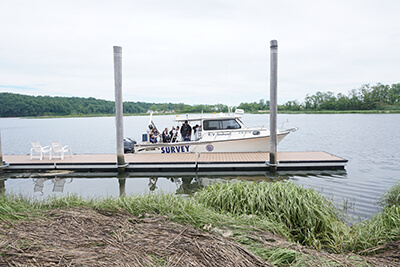
Aerial Drone Applications in Environmental Mapping and Education
Faculty Lead: Dr. Geoffrey Fouad, Dept. of History and Anthropology, with UCI Marine Scientist Jim Nickels; Dr. Richard Veit, Dept. of History and Anthropology; Dr. Pedram Daneshgar, Dept. of Biology; and UCI Associate Director Dr. Thomas Herrington
Aerial drone images will be captured from multiple altitudes to help visualize the topography of marsh and maritime forest areas near the Monmouth Marine and Environmental Field Station in Rumson, conduct beach surveys, and monitor archaeology sites. The project will use the drone to continuously sample dynamic coastal areas and develop innovative processing and visualization methods to analyze the data.
Cyanobacterial Harmful Algal Blooms in New Jersey Coastal Lakes: An Experimental Assessment of Deal Lake in Monmouth County
Faculty Lead: Dr. Jason Adolf, Dept. of Biology
This grant will be used to purchase equipment for Dr. Adolf to research factors that have resulted in a recent expansion of harmful algal blooms in coastal lakes. The equipment will be used by Dr. Adolf’s Ecosystems Analysis class to analyze plankton populations and water quality at Deal Lake over time and to better understand nutrient conditions that favor the onset of these events.
Discovering the Ecological Self and Assessing Student Outcomes of Discovering the Ecological Self
Faculty Leads: Kimberley Callas, Dept. of Art and Design, and Dr. Megan Delaney, Dept. of Professional Counseling; with Dr. Pedram Daneshgar, Dept. of Biology
In this two-prong project, Professor Callas will work with students from the Aslan Youth Ministry to create 3-D printed mask artwork inspired by local beach environments and reflections on what that environment means to them. Dr. Delaney will explore whether the students’ immersion in art and nature changed their perspectives on coastal stewardship.
Disappearing Cattails: Documentary Video Project
Faculty Lead: Dickie Cox, Dept. of Communication, with Dr. Pedram Daneshgar, Dept. of Biology
Students will create a documentary that shows Jersey Shore cattails to be emblematic of the global problem of invasive species disrupting coastal ecosystems. The film will highlight Dr. Daneshgar’s research of how invasive reeds (phragmites) are displacing cattails along local waterfront habitats and will be submitted to a number of regional and science-based film festivals.
Establishing A Gillnet Survey to Examine Population Demographics of Atlantic Sturgeon within the Restricted Waterways of Naval Station Earle and Sandy Hook Bay
Faculty Lead: Dr. Keith Dunton, Dept. of Biology
Dr. Dunton will expand upon previous UCI-funded research on the populations and behaviors of the endangered Atlantic sturgeon in area waterways. Prior research has focused on monitoring tagged Atlantic Sturgeon with underwater acoustic receivers. The present research will provide a better estimate of the present Sturgeon population by sampling tagged and untagged fish through gillnet surveys.
Impact of Interdisciplinary Team Teaching on Development of Student Critical Thinking Skills
Faculty Lead: Dr. Heide Estes, Dept. of English, with School of Science Associate Dean Dr. Catherine Duckett
The funding will provide partial support for an ongoing assessment of how students respond to a team of teachers representing separate areas of expertise while completing a course that explores the topic of climate science from the perspectives of biology and literary studies. The assessment will determine if interdisciplinary team teaching improves students’ critical thinking, sense of environmental value and civic engagement.
Using Population Genetics to Inform Management of New Jersey Fisheries
Faculty Lead: Dr. Megan Phifer-Rixey, Dept. of Biology, with School of Science Assistant Dean John Tiedemann
The funding will support efforts by the Marine and Environmental Biology and Policy Program to determine the region(s) of origin for striped bass in northern Ocean County, and estimate the historic population sizes of Atlantic sturgeon through genetic data analysis. DNA collected from the stripers and sturgeon will be analyzed to provide estimates of population size, help identify distinct fish population segments relevant for conservation, and provide other information regarding diversity within and among populations.
What Lies Beneath?
Faculty Lead: Dr. Richard Veit, Dept. of History and Anthropology, with UCI Marine Scientist Jim Nickels
New Jersey shipwreck information and artifacts available in local museums and other repositories will be inventoried for Dr. Veit and Nickels’ Underwater Archaeology course.
This research is being funded by the UCI’s Marine Science and Policy Initiative, which is supported through the generosity of many private and corporate donors. If you would like to make a tax-deductible gift to the UCI, please use our Give a Gift Now contribution form.
NJ League of Municipalities Panel Probes Beach Access, Resilience Issues
Atlantic City averaged five nuisance floods per year in 1950, according to UCI Associate Director Dr. Thomas Herrington. Today it experiences two dozen.

While sea level rise is accelerating, funding for beach replenishment and other coastal resilience projects is not, Herrington told an audience of elected officials on Nov. 15 at the New Jersey League of Municipalities Conference, held at the Atlantic City Convention Center. Faced with this mounting challenge, he advised coastal communities to begin taking independent steps to stem the tide, such as strengthening the natural barriers on their waterfronts.
“You don’t have to wait for the federal government to match your $35 with their $65,” he said. “You can start doing this work by yourselves. Maybe we can knock down those incidents from 24 to 10.”
Herrington and UCI Director Tony MacDonald participated on the panel “It’s a Shore Thing: Public Access and Resiliency” along with Michael Moriarty of the Federal Emergency Management Agency (FEMA), State Sen. Bob Smith and Bill Sullivan of the law firm Scarinci Hollenbeck. The discussion was moderated by Monmouth Beach Mayor Susan Howard.
Smith, the chair of the Senate Environment and Energy Committee, kicked off the discussion with a preview of legislative priorities for the 2018 session. He said the Senate is currently working on a beach access bill that would provide a stronger statutory basis for the public trust doctrine – a legal principle established by the courts that grants the public the right to access waterfront areas. Smith said the bill would also provide guidance for important exceptions, such as when national security could be compromised or access points are environmentally sensitive. He said Gov. Phil Murphy and the Legislature also have big plans for resilience projects and financing green infrastructure.
“You add it all up and we are going to be humming for the next four years,” he said.
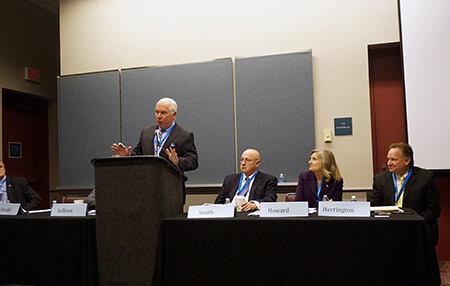
MacDonald said if New Jersey is going to be successful planning for the future of beach access and resilience, its leaders need to begin thinking of the issues together. Often municipalities view beaches as places for recreation and tourism, while the Army Corps of Engineers invests in their replenishment for other reasons.
Responding to an audience member’s question about the feasibility of retreat in the densely developed Jersey Shore, MacDonald said the strategy is not realistic at a large scale without providing significant local government assistance and initiatives for private land owners.
According to Herrington, a Congressional post-Sandy analysis found that replenished beaches exceeded expectations, while the devastation was far worse in areas where projects hadn’t been completed.
“We’re entering a period where for the first time, the majority of our shoreline is benefiting from these coastal protection projects. The last [non-engineered] area is being done right now in Ocean County,” Herrington said. “We can’t stop now. In order to make our shoreline resilient, we need to maintain our beaches and dunes, but it’s going to cost us more in the future.”
Roundtable Explores Emerging Options for Financing Coastal Resilience
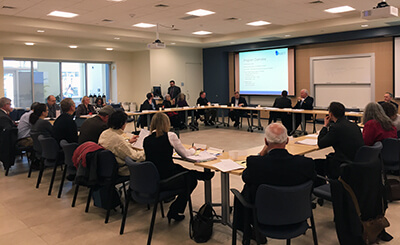
Several of the state’s top tax, finance, real estate, land use, resilience and municipal government experts gathered at Monmouth University on Dec. 14 for a roundtable discussion focused on coastal resilience financing mechanisms that could work in New Jersey and the elements necessary for their success. The event was part of the UCI’s ongoing work to help communities devastated by Hurricane Sandy improve their resilience and preparedness for future storms.
The goals of the session were to identify available and/or innovative financing mechanisms that can support long-term planning and implementation of community resilience and adaptation projects and programs; identify legislative, rulemaking, policy or programmatic changes needed to facilitate implementation; and identify the most promising opportunities for action, and potential communities where mechanisms or pilot projects can be implemented. Presentations were made on mechanisms such as the New Jersey Blue Acres Program, transfers of development rights, environmental impact and resilience bonds and the New Jersey Environmental Infrastructure Trust Program, among others.
As part of the New Jersey Department of Environmental Protection’s (NJDEP) Resilient Coastal Communities Initiative (RCCI), the UCI prepared the 2016 report Recommendations for Resilient Coastal Communities in New Jersey, which concluded that the full participation of municipal governments will be critical to the success of resilience efforts in the state. However, each community the RCCI project partners approached identified a lack of capacity as the largest barrier to participation in resilience planning and preparedness efforts. To address this threshold issue, the report recommended steps be taken to identify and evaluate both traditional and innovative new financing options for coastal community resilience planning, projects and programs. The roundtable was held in part to advance that recommendation.
For more on the UCI’s work in this area, see our Community Resilience and Climate Adaptation page.
Barnegat Bay Zooplankton Study Published in Journal of Coastal Research
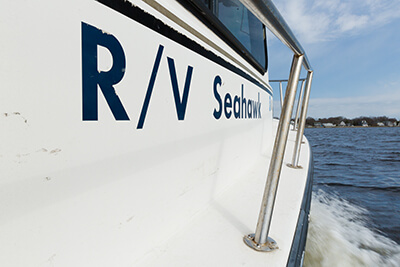
UCI Marine Scientist Jim Nickels was among the authors of a recent article in the Journal of Coastal Research examining changes in Barnegat Bay’s zooplankton community and the organisms’ vulnerability to climate change. The article was included in a special issue dedicated to a series of research projects that were commissioned by the New Jersey Department of Environmental Protection as part of a comprehensive study of the overall health of Barnegat Bay. Read a web version or
download a PDF of the print version.
Ocean Stories: In Gotham City, a Dark Sight Rises
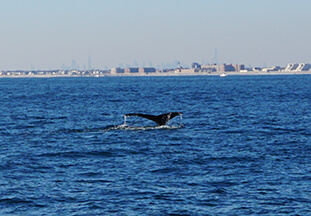
UCI Communications Director Karl Vilacoba rode along with Gotham Whale to talk about the resurgence of humpbacks in New York Harbor and the group’s citizen science work for this Ocean Stories feature published on the Mid-Atlantic Ocean Data Portal. For best viewing of the story’s scrolling data maps, a non-mobile device is recommended.
ROVing the Depths of the Monmouth University Pool

December is the perfect time for mini-golf and fun at the pool. In what’s become something of a holiday season tradition at the UCI, Marine Scientist Jim Nickels brought his MEBP Field Methods in Marine Sciences students (seen here) and several high school classes to the Monmouth University pool last week for some fun challenges designed to train them to use Remote-Controlled Underwater Vehicles (ROV).
Students practiced using the ROVs to drop golf balls in a hole and maneuver through obstacle courses, sharpening their skills with the technology in the process. The controllers are similar to those of a video game, and cameras mounted to the equipment allow students to see from the ROVs’ perspective on a TV screen.
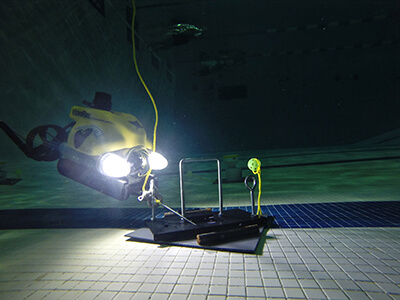
Capable of reaching depths of 1,000 feet underwater, ROVs can be used anywhere that you wouldn’t want to send a diver. And unlike humans, they have the advantage of being able to stay underwater indefinitely. In one notable project, an ROV was placed in the North Sea continuously for about 18 months. They are commonly used for tasks such as observing fish populations, mapping surveys, observing oyster reefs and gaining positioning information.
The UCI’s ROV can record footage for later playback and also has a laser scaler feature which is used as a tool to measure the size of objects seen on camera. The UCI owns one ROV and manufacturer Video Ray has provided two additional vehicles for student training.
View photos of Monmouth University students training on Dec. 1. Throughout the week, students from Henry Hudson Regional High School, the Marine Academy of Science and Technology, and the Marine Academy of Technology and Environmental Sciences also went through training.
Monmouth University Named to Surfer Magazine‘s Best Surf Colleges
Surfer Magazine ranked Monmouth University #10 on its list of Best Surf Colleges! Per the article: “Widely considered one of the top private schools in the region, Monmouth offers degrees in 26 undergraduate programs, plus a bounty of learning opportunities for ocean-inclined students through the school’s Urban Coast Institute and internships with the New Jersey Division of Fish and Wildlife.” Read the magazine’s Monmouth University profile.
Register for 1/18 Gulf of Mexico Loop Current Webinar
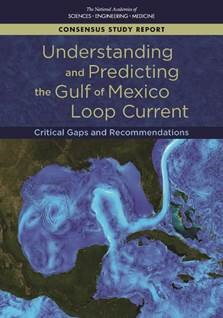
Monmouth University President Emeritus and UCI Ocean Policy Fellow Paul G. Gaffney II will serve as a panelist on a Jan. 18 webinar about a new report and funding opportunities related to the Gulf of Mexico Loop Current System.
The Loop Current System is the dominant ocean circulation feature in the Gulf of Mexico, influencing all types of ocean processes, and its behavior has implications for a variety of human and natural systems. However, despite the far-reaching impact of the Loop Current System, knowledge about the underlying dynamics that control its behavior is limited. The National Academies of Sciences, Engineering, and Medicine undertook a study to identify existing knowledge gaps about the Loop Current System and to develop a list of recommended efforts to fill those gaps. The resulting report,
Understanding and Predicting the Gulf of Mexico Loop Current, calls for an international, multi-institutional campaign of complementary research, observation, and analysis activities that would help improve understanding and prediction of the Loop Current System. Gaffney serves as the chair of the Committee on Advancing Understanding of Gulf of Mexico Loop Current Dynamics, which authored the report.
Monmouth U. Photography Instructor’s Post-Sandy Images Featured in National Geographic
Congratulations to Ira Wagner of the Monmouth University Department of Art and Design, whose images of Superstorm Sandy reconstruction efforts were featured in the December issue of National Geographic.
In 2016, Wagner and fellow Monmouth University photography instructor Mark Ludak’s joint photo exhibition “Watersides” explored the vulnerability of our coast and way of life to climate change and sea level rise. Wagner’s photos focused on the phenomenon of house-raising at the Jersey Shore, which was spurred by the catastrophic flooding caused by the 2012 storm. Wagner was intrigued by people’s determination to risk rebuilding in waterfront areas, despite the near certainty that their properties would flood again, perhaps worse than before.
Watch below as UCI Director Tony MacDonald moderates a panel discussion with Wagner, Ludak and seascape artist Lucy Kalian about their work.
Video: Vintage Submerged Locomotive Wrecks off Long Branch
This Remote-Controlled Underwater Vehicle footage taken a few summers ago by UCI Marine Scientist Jim Nickels and Monmouth University students shows two Civil War-era locomotives standing upright about 6 miles east of Long Branch. Look out for the surprisingly well-preserved wheels and the marine life teeming around the wrecks.
New Jersey Meeting for Federal Offshore Oil & Gas Leasing Program Feb. 14
 A New Jersey public meeting on a federal proposal that would open the East Coast to offshore oil and gas exploration will be held from 3-7 p.m. on Feb. 14 at the Hilton Garden Inn, 800 U.S. Highway 130, in Hamilton. The meeting will use an open-house format, so participants can arrive any time during the meeting.
A New Jersey public meeting on a federal proposal that would open the East Coast to offshore oil and gas exploration will be held from 3-7 p.m. on Feb. 14 at the Hilton Garden Inn, 800 U.S. Highway 130, in Hamilton. The meeting will use an open-house format, so participants can arrive any time during the meeting.
Read more information on the National Outer Continental Shelf Oil Gas & Leasing Program, including instructions for submitting a comment.
In Memoriam: Gov. Brendan T. Byrne

The UCI extends its condolences to the family and friends of the late Gov. Brendan T. Byrne, including UCI Advisory Committee member Nancy Byrne Reinhart. Gov. Byrne was widely regarded as a friend of New Jersey’s environment and one of the most influential governors in the state’s history, with legislative achievements that include introducing gaming to Atlantic City and launching the Meadowlands sports complex. Yet his proudest and perhaps most enduring legacy is his 1979 approval of the Pinelands Preservation Act, which protects vast swaths of pristine New Jersey forest areas to this day. Gov. Byrne is seen here talking about the Pinelands with Monmouth University students in 2011.

